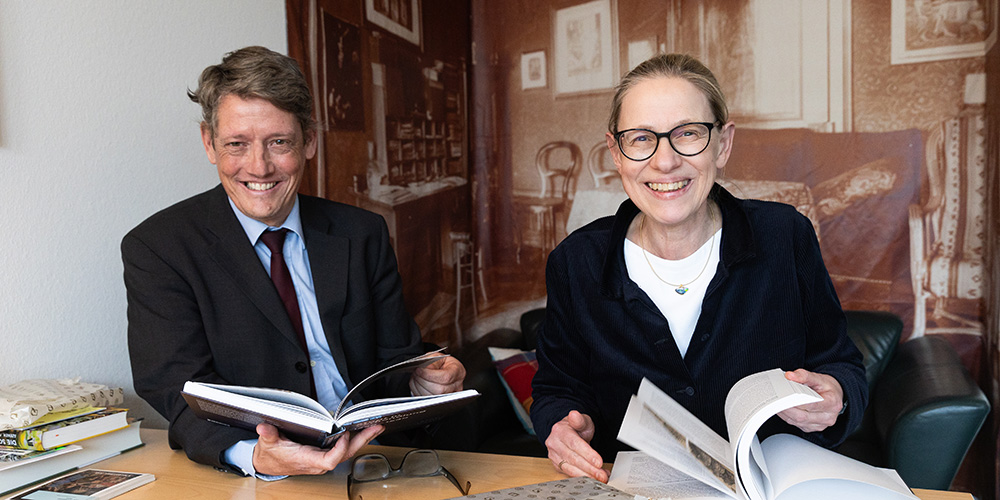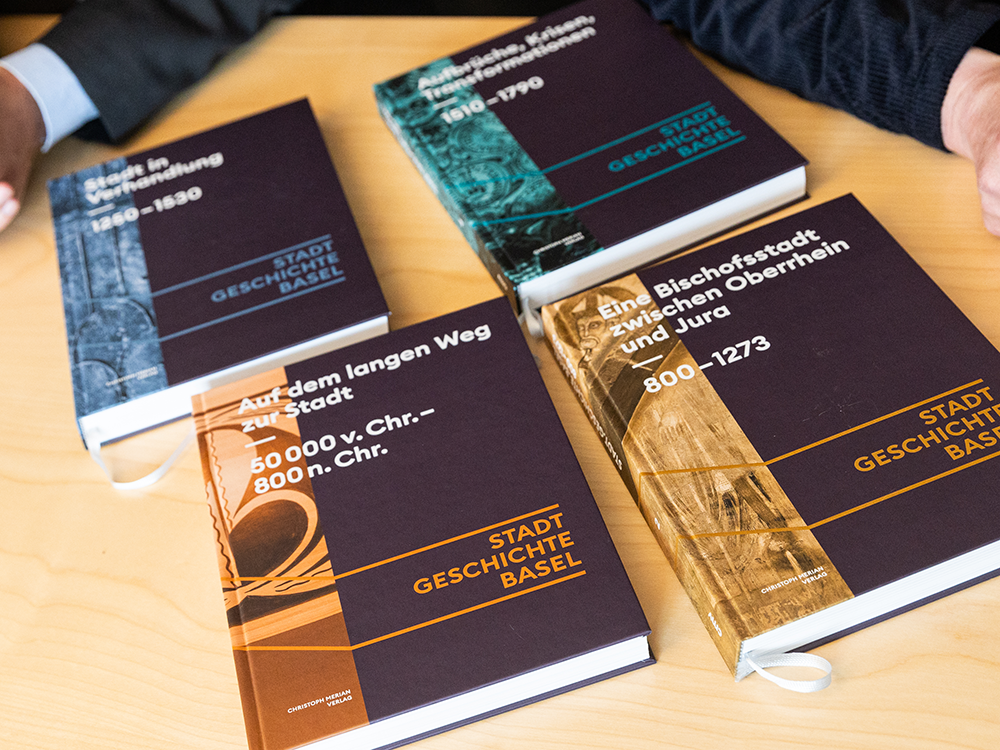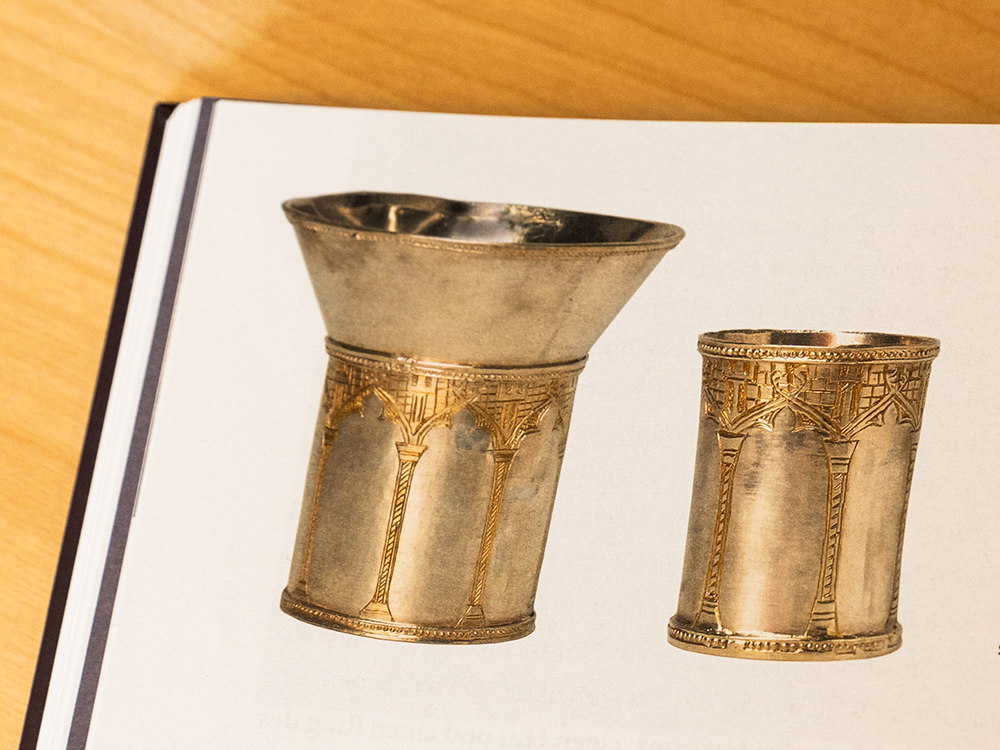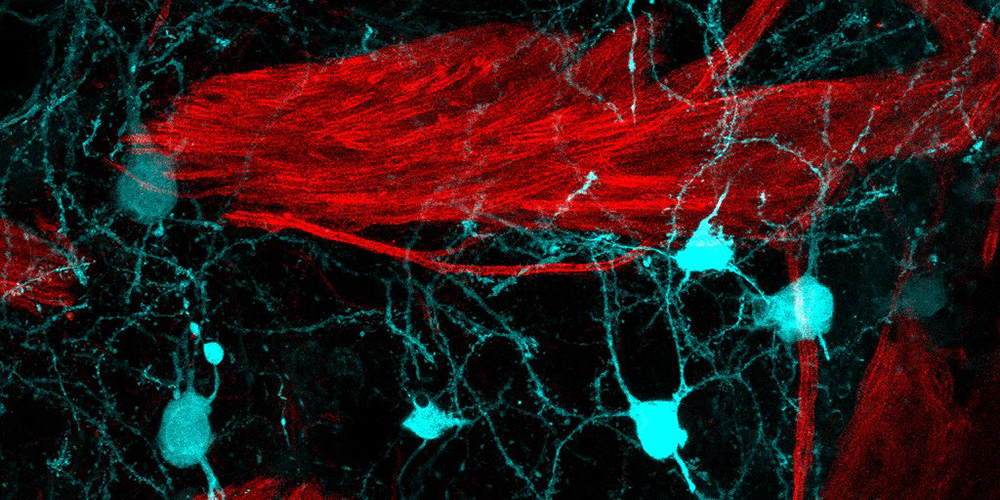A look at the past with current standards
Stadt.Geschichte.Basel (City.History.Basel) provides the city of Basel with a new full representation of its own history in a total of ten volumes. Numerous researchers at the University of Basel are involved in the project as both editors and authors. The comprehensive work is more than just a chronological account of events.
11 March 2024 | Noëmi Kern
It’s a special moment when Lucas Burkart, professor of medieval and Renaissance history, and Susanna Burghartz, professor emerita of Early Modern history, remove the protective paper from the books. They have been working on this project for a long time as both authors and members of the editorial board. Now they have the first four volumes of Stadt.Geschichte.Basel before them, which focus on the history of the city of Basel from 50,000 BCE to the present.
“Our task was to take the wealth of sources and researches and create a narrative that emphasizes the major themes that have characterized the history of the City of Basel right down to the present day,” Burghartz explains. “Since the 19th century our perspective is strongly influenced by nation-states, which is too narrow a view,” Burkart adds. “At times, Mulhouse was far more important to Basel than Bern or Zurich was, for example.”
The special case of Basel
The publication will eventually include a total of nine volumes and a summary volume. Covering around 52,000 years, it’s the first history of Basel to encompass such a long period of time. The last multi-volume city history, Rudolf Wackernagel’s Geschichte der Stadt Basel, is 100 years old and ends with the Reformation. “The view back then was that that represented the achievement of society’s aims,” Burkart says. Unlike other cantons, such as Zurich, Bern or Basel-Landschaft, which commissioned their cantonal histories already in the 1970s and 1980s, Basel took more time: The Basel Grand Council only approved funding (4.4 million franks) for the project in 2016. The initiative for the project came from the public.
The population of Basel has an “intense relationship with history,” Burkart says. “For example, there are many family archives that are currently held by the Basel Public Record Office. There is also a major culture of collecting things.” The city’s past as a printing center and the long history of the university also made for exceptionally good conditions for the preservation of primary sources.
Disciplinary diversity
The University of Basel also plays an important role in indexing and presenting sources in accordance with the latest scholarly methods. “But the history of the city is not simply a matter of the canton commissioning academics for it; it has a much broader basis than that,” Susanna Burghartz emphasizes.
She says the collaboration between the various institutions of historical memory, such as the University Library, the Public Record Office, the Offices of Archaeological Investigations and Historical Preservation, the Historical Museum and many others has been excellent. “Also, the fact that the texts originate with a group of authors rather than a single person who is compiling everything helps to maintain a diverse perspective of the city and its history,” Burghartz notes.
Burkart and Burghartz repeatedly emphasize that the “city” in question refers to more than just what was or is contained within the city walls or the cantonal border. They speak a lot about networks and ties that stretched as far as the Caribbean or India, even in the Early Modern period. “We zoom in and back out again to illustrate various themes and, at times, contradictory tendencies,” Burghartz explains. “Often, alongside watershed moments such as the beginning or end of a war, there are various other developments taking place at the same time and intertwining with each other. History is not linear. Transitions are fluid.” For this reason, current approaches to history do not regard divisions into fixed era dates as useful.
Concrete objects instead of digital content
In order to paint the broadest and most diverse picture possible, the editors considered it important not to rely solely on written sources. “Interest in material history is also constantly increasing in more modern approaches to the discipline,” Susanna Burghartz says.
After all, things are historical objects that influence history and can tell us about people’s daily lives. “The silver cups belonging to the Jewish community, for instance, provide proof that this community existed in Basel – including during the period between the pogrom of 1349 and the 16th century, when Basel became a center for the printing of Hebrew-language books,” Lucas Burkart explains.
The books include pictures of these kinds of material sources as well as graphics and maps. “The books are intended to invite readers to leaf through them and make discoveries. We tried to avoid endless seas of text as much as possible,” Burkart says. The authors also endeavored to keep their language accessible. “We intentionally decided against including a glossary. The meaning of terms should be able to be determined from the text.”
They are intentionally forgoing a digital expansion of the books, and QR codes are nowhere to be found. According to Susanna Burghartz, “The books are also a plea for a longer attention span than is usual today when consuming digital content. We want to invite people to think differently than before.”
About «Stadt. Geschichte. Basel»
The desire for a comprehensive portrayal of the history of Basel goes back to the 20th century. The Stadt.Geschichte.Basel project was brought to life in 2011 by the Verein Basler Geschichte (Basel History Association). The driving force behind the project is Basel Germanist and historian Robert Labhardt, president of the Verein Basler Geschichte. In 2016, Basel’s parliament authorized funding of 4.4 million franks for the project. 1.6 million of that is from Swisslos, with the remaining 3.3 million being contributed by foundations, institutions, companies and private donors.
Volume 1: Auf dem langen Weg zur Stadt. (The long path to becoming a city) 50,000 BCE – 800 CE
Volume 2: Eine Bischofsstadt zwischen Oberrhein und Jura. (A diocesan town between the Upper Rhine and Jura). 800–1273 CE
Volume 3: Stadt in Verhandlung. (The city under negotiation). 1250–1530 CE
Volume 4: Aufbrüche, Krisen, Transformationen. (Awakenings, crises, transformations). 1510–1790 CE





